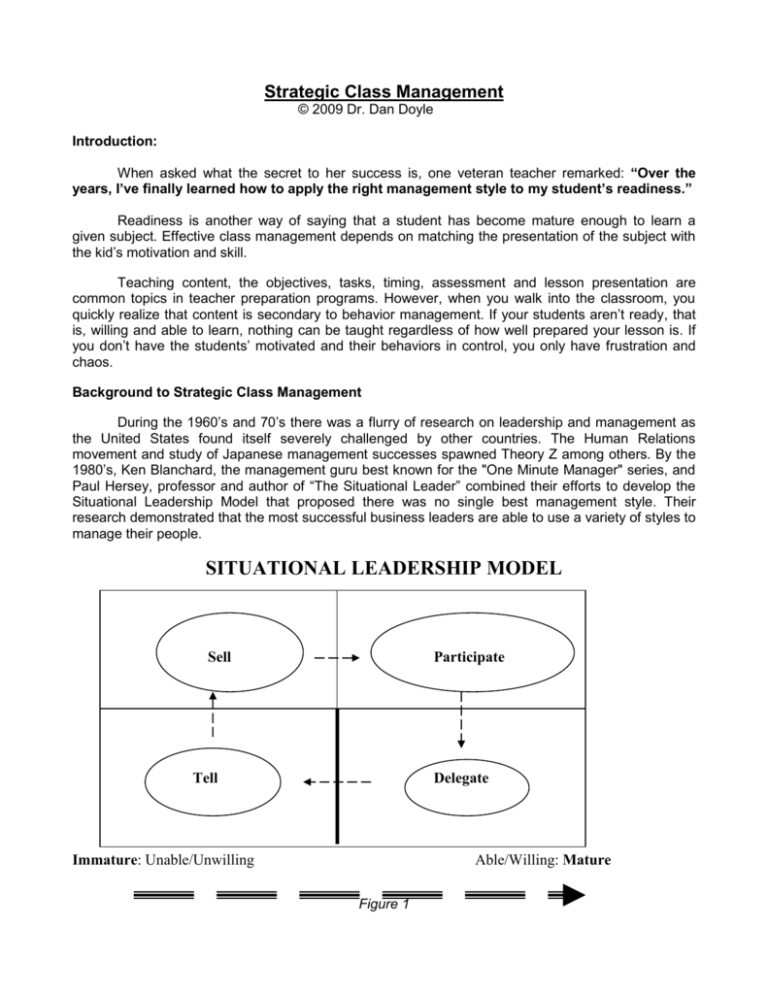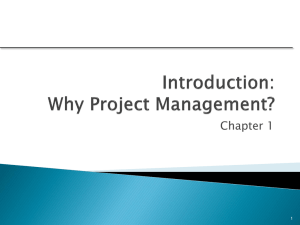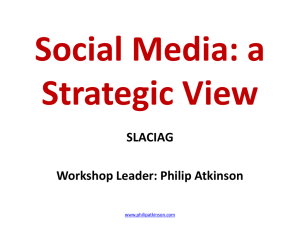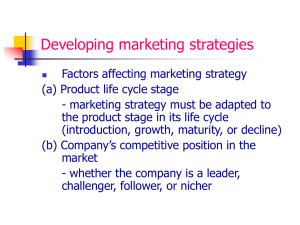Strategic Classroom Management - Great Wall Chinese Academy
advertisement

Strategic Class Management © 2009 Dr. Dan Doyle Introduction: When asked what the secret to her success is, one veteran teacher remarked: “Over the years, I’ve finally learned how to apply the right management style to my student’s readiness.” Readiness is another way of saying that a student has become mature enough to learn a given subject. Effective class management depends on matching the presentation of the subject with the kid’s motivation and skill. Teaching content, the objectives, tasks, timing, assessment and lesson presentation are common topics in teacher preparation programs. However, when you walk into the classroom, you quickly realize that content is secondary to behavior management. If your students aren’t ready, that is, willing and able to learn, nothing can be taught regardless of how well prepared your lesson is. If you don’t have the students’ motivated and their behaviors in control, you only have frustration and chaos. Background to Strategic Class Management During the 1960’s and 70’s there was a flurry of research on leadership and management as the United States found itself severely challenged by other countries. The Human Relations movement and study of Japanese management successes spawned Theory Z among others. By the 1980’s, Ken Blanchard, the management guru best known for the "One Minute Manager" series, and Paul Hersey, professor and author of “The Situational Leader” combined their efforts to develop the Situational Leadership Model that proposed there was no single best management style. Their research demonstrated that the most successful business leaders are able to use a variety of styles to manage their people. SITUATIONAL LEADERSHIP MODEL Sell Participate Tell Delegate Immature: Unable/Unwilling Able/Willing: Mature Figure 1 Hersey and Blanchard characterized leadership style in terms of the amount of Task Behavior and Relationship Behavior that the leader provides to their followers. They categorized all leadership styles into four behavior types, which they named S1 to S4: S1: Telling - is characterized by one-way communication in which the leader defines the roles of the individual or group and provides the what, how, when, and where to do the task S2: Selling - while the leader is still providing the direction, he or she is now using two-way communication and providing the socioemotional support that will allow the individual or group being influenced to buy into the process. S3: Participating - this is now shared decision making about aspects of how the task is accomplished and the leader is providing less task behaviors while maintaining high relationship behavior. S4: Delegating - the leaders is still involved in decisions; however, the process and responsibility has been passed to the individual or group. The leader stays involved to monitor progress. Of these, no one style is considered optimal for all leaders to use all the time. Effective leaders need to be flexible, and must adapt themselves according to the situation. Maturity Levels The right leadership style will depend on the person or group being led - the follower. The HerseyBlanchard Situational Leadership® Theory identified four levels of Maturity M1 through M4: M1 - They generally lack the specific skills required for the job in hand and are unable and unwilling to do or to take responsiblity for this job or task. M2 - They are still unable to take on responsibilty for the task being done; however, they are willing to work at the task. M3 - They are experienced and able to do the task but lack the confidence to take on responsiblity. M4 - They are experienced at the task, and comfortable with their own ability to do it well. They able and willing to not only do the task, but to take responsibility for the task. Maturity Levels are also task specific. A person might be generally skilled, confident and motivated in their job, but would still have a Maturity level M2 when asked to proform a task requiring skills they don't possess. Differentiation and Strategic Class Management It is a practical step to apply many of the theories, concepts and research from management literature to the classroom. A primary method of differentiation is to quickly identify when to apply what type of classroom management procedure or intervention based upon the student’s task level maturity. Strategic Class Management proposes that a master teacher is able to accurately assess or anticipate an individual student’s and/or a group’s maturity level - that is, “How willing and to what degree are my students able to accomplish a given learning task in a certain situation?” In making this assessment, the teacher has the capability to manipulate at least Six Variables: 1. The content to be learned 2. The task itself - or how it is to be learned 3. The time period and length of time when the lesson is to be learned, 4. The situation - e.g. whether the lesson is to occur in a small group, cooperative learning exercise, or as a lecture 5. The intervention 6. His or her own management of student behavior. SCM provides a model for looking at many levels regarding classroom management. Schools may be situationally immature - e.g. when a school district has decided to switch from a junior high to a middle school model, the entire school district becomes immature. Thus, everyone needs to be taught and told how to proceed and what to expect. A beginning teacher is obviously situationally immature as is a teacher, regardless of years of experience, who has been assigned to a new building. SCM helps administrators understand which leadership style to use with different teachers. The model would predict that teachers who (a) understand the cognitive, emotional, and social development and stage of the group assigned, (b) understand the particular school, school district, and community, and (c) the more individual information the teacher has regarding the students and their backgrounds, then the more “situationally mature” the teacher is, and therefore, the more likely the teacher is able to match classroom management style with the incoming students. The model would predict that schools which have stable populations of students, with a stable population of teaching staff and administration should experience fewer discipline problems because the staff is able to learn much about the student’s situational maturity. Schools with high turnover of students and staff would be chronically in an “immature” situation. SCM suggests that teachers need a high degree of awareness of their own teaching style, of available teaching and classroom management strategies, of individual and special needs management. Class Management based on Maturity Level The successful teacher can evaluate their students’ task maturity level and then apply the appropriate management style in teaching the lesson. More experienced and effective teachers begin the year by telling their “situationally immature” students in a very concrete and directive manner what their expectations are regarding behavior, quantity and quality of work, and so on. Likewise, new lessons would generally start in a directive, concrete manner. As the student “matures” in the lesson and school, effective teachers become less directive and more abstract. An effective teacher shifts strategies as the child grows and learns in each specific situation for every task. For example in the beginning stage of task-level maturity, the teacher says in a very directive and concrete manner: “We are going to study Africa”. The next communication is a persuasive and more specific instruction “We will get to watch some really exciting films and read several books on the animals and people of Africa.” As the student gains insight, the teacher uses a negotiation and more detailed instruction regarding when and how their new knowledge will be proved by saying: “We will have three weeks to do this, at the end of that time, you can show that you have learned about Africa by doing well on a test, writing a paper, or doing a travel brochure on Africa.” Finally, at the highest level, when the students have gained sufficient ability and willingness, the teacher may delegate and monitor by saying: “Ok, you get started; I’ll walk around the room to help you when you need it.” One Model of Strategic Class Management Less Directive Child is able/willing DELEGATE+ MONITOR D E C I S I O N S Child is able/unwilling USE PARTICIPATION INSTRUCTION ON WHY HOW & WHEN Child is unable/willing USE COACHING/PERSUASION WHERE, RESULTS, HOW, Child is unable/unwilling USE TELLING/DIRECT TEACHING WHY, WHAT, WHO Directive Concrete Communication Abstract Figure 2 Research on SCM Students in a teacher preparation program and teachers with 10 or more years of experience were asked to categorize a list of 101 interventions, placing these interventions into one of the “boxes” of the SCM model. reviewed a list of 101 classroom interventions and categorized them into each of the four classroom management styles. Based upon those responses, the original list of 101 was pared down to 35 where there was a degree of consensus and re-categorized according to the four “levels” of student maturity. Those interventions with more than 55% agreement are shown, according to the SCM model, as follows: VERY MATURE = DELEGATE – turn it over *Appoint the child as class secretary to record other children working or being off task *Have the entire class brainstorm rules for the students to help them solve problems. *Allow more time to pass in the hallways, use the bathroom, etc. MORE MATURE = INVOLVE and have PARTICIPATE *Have the child use head or earphones to help with auditory understanding when you are lecturing *Place the child in a study carrel to reduce distractions *Have student repeat instructions back to you before he/she starts the activity *Help the child get organized with planners, desk materials, etc. LESS MATURE = SELL and COACH *Set up a daily or weekly home-school report *Have the student view a video on “Manners” or 10 things to do instead of hitting *Develop a group reward contingent on the student doing well so others will encourage the student such as: "If Bill is able to get to class on time every day this week, we will have a movie on Monday everyone try to help him make it here.” *Use physical proximity to help keep the student focused on work VERY IMMATURE = TELL and TEACH *Use clear understandable worksheets *Have the child take a 5 minute time-out *Post and review clear, simple class rules for behavior *Move the student’s desk next to the teacher’s *Disciplinary referral to the office *Video tape the child’s behaviors and conference with parent to review video *Use black ink and clear, uncluttered tests and other forms *Ask other staff member(s) to periodically talk with or step into the room to check on the student whom you have concerns about A pilot study using self-report measures indicated that the more experience a teacher has, the more they use selling and the less they delegate to students. Males tell more while female teachers tend to use more participation. Those with more experience are more neutral and objective in their style. High school teachers are more neutral than elementary teachers. Summary: Most difficult to define and measure yet of critical significance is the relationship between teacher and student(s). Relationships between students and teachers vary from the extreme of overprotective, over-involved, smothering and dependent relationship where the teacher may actually do the work for the child in order to prevent any negative feelings. At the other extreme is the threatening, rejecting, cold, judgmental relationship where the teacher appears to not care about the emotional well-being of the student. Strategic Class Management is both a diagnostic and predictive tool that helps teachers quickly decide what kind of leadership style to use with different students based on the child’s motivation and skill level. If the child is acting up and being immature during a lesson or activity, he quickly needs to be told why the lesson is important, what is expected and what outcomes can be expected for compliance versus ongoing immature behavior. It is a relationship and competence building process that may be an important tool for differientation of instruction.








